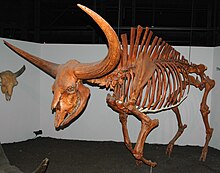长角野牛
哺乳动物物种
长角野牛(学名:Bison latifrons),或称作宽额野牛,是一种已绝种的美洲野牛属,生活于 200,000 年前更新世时期的北美洲,大约于 21,000 至 30,000 年前末次冰盛期开始时灭绝。
| 长角野牛 化石时期:
| |
|---|---|

| |
| 长角野牛全身骨架 | |
| 科学分类 | |
| 界: | 动物界 Animalia |
| 门: | 脊索动物门 Chordata |
| 纲: | 哺乳纲 Mammalia |
| 目: | 偶蹄目 Artiodactyla |
| 科: | 牛科 Bovidae |
| 属: | 野牛属 Bison |
| 种: | †长角野牛 B. latifrons
|
| 二名法 | |
| †Bison latifrons | |
描述
编辑长角野牛的肩高可达 2.5米(8.2英尺) ,体重则可达 2,000千克(4,400英磅) 。体型与生存于非洲的佩罗牛属匹敌,而体重则超越现存的长颈鹿。长角野牛的角两角角尖相距可达213厘米(84英寸),而现存美洲野牛的两角角尖相距仅有66厘米(26英寸)[2]。而身体尺寸也明显超越现存所有的牛,包括目前仅存的两种野牛 - 美洲野牛与欧洲野牛。根据长角野牛与美洲野牛肢骨长度的比较,推算出长角野牛可能比美洲野牛还重上25%–50%[3]。事实上,长角野牛可能是所有已知种类中体型最大的牛[4]。
演化
编辑长角野牛被认为演化自生活于中部北美大陆的西伯利亚野牛族群,这些野牛在 240,000 至 220,000 年前透过白令陆桥从西伯利亚迁徙至北美洲[5][6][7]。长角野牛属于在第四纪灭绝事件中绝种的北美洲巨型动物群之一,大约绝种于 21,000 至 30,000 年前(大约在威斯康辛冰期)[2]。长角野牛绝种后的区位由体型较小的古风野牛取代,并在约 10,000 年前演化成体型更小的美洲野牛[8]。
行为与栖息地
编辑长角野牛为草食动物,在北美大平原与林地上行小群体放牧生活。长角野牛喜欢较温暖的气候,在现今加州的圣地亚哥有化石纪录出土[9]。雄性巨大的长角被认为是用来同性之间性展示或是用来抵御当时的大型掠食者(包括斯剑虎[10]以及巨型短面熊[11])用。在2014年,墨西哥国家文物总局在墨西哥南部格雷罗州的奇尔潘辛戈发现长角野牛的遗骸[12]。
参考文献
编辑- ^ Harlan, R. Bos latifrons, (nobis.): Broad headed Fossil Ox. Fauna americana: being a description of the mammiferous animals inhabiting North America. Philadelphia: Anthony Finley. 1825: 273.
- ^ 2.0 2.1 Kurten, B; Anderson, E. Order Artiodactyla. Pleistocene mammals of North America 1st. New York: Columbia University Press. 1980: 295–339 [2018-10-15]. ISBN 0-231-03733-3. (原始内容存档于2019-07-10).
- ^ Hoganson, JW. Occurrence of the Giant Ice Age Bison, Bison latifrons, in North Dakota (PDF). NDGS Newsletter. 2002, 29 (2): 1–3 [2018-10-15]. ISSN 0889-3594. (原始内容存档 (PDF)于2017-01-25).
- ^ Bison Latifrons - Characteristics, Behavior and Habitat of Bison Latifrons, the Giant Bison. Dinosaurs.about.com. 2010-12-18 [2012-05-13]. (原始内容存档于2013-11-10).
- ^ Bell CJ. The Blancan, Irvingtonian, and Rancholabrean mammal ages. Woodburne, M.O. (编). Late Cretaceous and Cenozoic Mammals of North America: Biostratigraphy and Geochronology. New York: Columbia University Press. 2004: 232–314. ISBN 0-231-13040-6.
- ^ Scott E, Cox SM. Late Pleistocene distribution of Bison (Mammalia; Artiodactyla) in the Mojave Desert of Southern California and Nevada. Wang X, Barnes LG (编). Geology and Vertebrate Paleontology of Western and Southern North America. Los Angeles: Natural History Museum of Los Angeles County. 2008: 359–82.
- ^ Sanders AE; Weems RE; Albright III LB. Formalization of the mid-Pleistocene "Ten Mile Hill beds" in South Carolina with evidence for placement of the Irvingtonian–Rancholabrean boundary. Albright III LB (编). Papers on Geology, Vertebrate Paleontology, and Biostratigraphy in Honor of Michael O. Woodburne. Flagstaff: Museum of Northern Arizona. 2009: 369–75.
- ^ Wilson, M.C. & L.V. Hills, B. Shapiro. Late Pleistocene northward-dispersing Bison antiquus from the Bighill Creek Formation, Gallelli Gravel Pit, Alberta, Canada, and the fate of Bison occidentalis. Canadian Journal of Earth Sciences. 2008, 45 (7): 827–59. doi:10.1139/E08-027.
- ^ Ice-Age Bison Fossil Found in San Diego. NBC 7 San Diego. 3 April 2013 [16 May 2013]. (原始内容存档于2019-12-07).
- ^ Carbone, C; Maddox, T; Funston, PJ; Mills, MG; Grether, GF; Van Valkenburgh, B. Parallels between playbacks and Pleistocene tar seeps suggest sociality in an extinct sabretooth cat, Smilodon. Biology Letters. 2009, 5 (1): 81–5. PMC 2657756 . PMID 18957359. doi:10.1098/rsbl.2008.0526.
- ^ Cassiliano ML. Biostratigraphy of Blancan and Irvingtonian mammals in the Fish Creek-Vallecito Creek section, southern California, and a review of the Blancan-Irvingtonian boundary. Journal of Vertebrate Paleontology. 1999, 19 (1): 169–86 [2018-10-15]. doi:10.1080/02724634.1999.10011131. (原始内容存档于2013-01-28).
- ^ Descubren en Guerrero fósiles de bisonte del Pleistoceno Tardío. www.inah.gob.mx. [29 July 2017]. (原始内容存档于2017-07-30) (欧洲西班牙语).